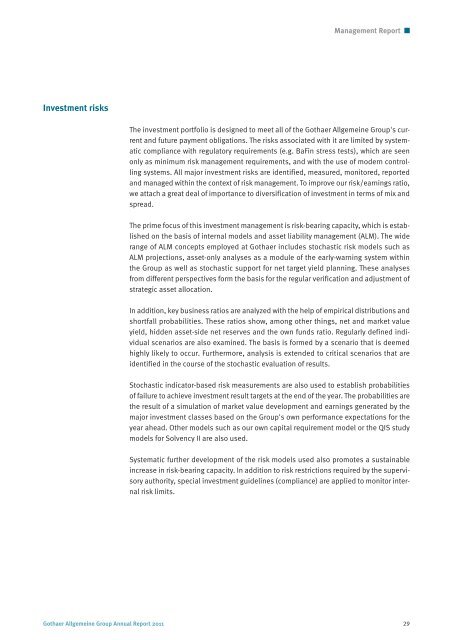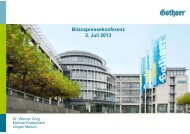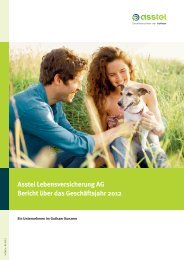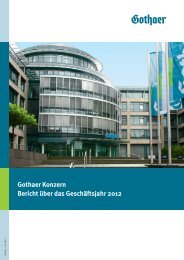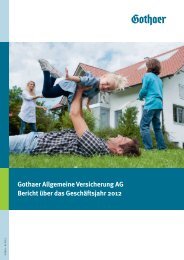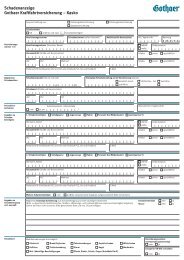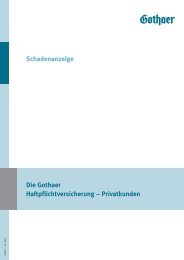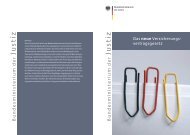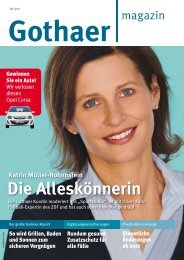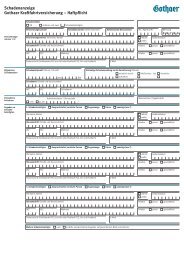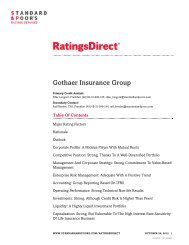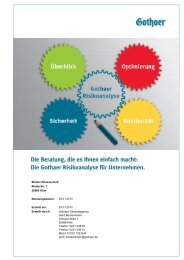Gothaer Allgemeine Versicherung AG Group Annual Report for ...
Gothaer Allgemeine Versicherung AG Group Annual Report for ...
Gothaer Allgemeine Versicherung AG Group Annual Report for ...
Create successful ePaper yourself
Turn your PDF publications into a flip-book with our unique Google optimized e-Paper software.
Management <strong>Report</strong><br />
Investment risks<br />
The investment portfolio is designed to meet all of the <strong>Gothaer</strong> <strong>Allgemeine</strong> <strong>Group</strong>'s current<br />
and future payment obligations. The risks associated with it are limited by systematic<br />
compliance with regulatory requirements (e.g. BaFin stress tests), which are seen<br />
only as minimum risk management requirements, and with the use of modern controlling<br />
systems. All major investment risks are identified, measured, monitored, reported<br />
and managed within the context of risk management. To improve our risk/earnings ratio,<br />
we attach a great deal of importance to diversification of investment in terms of mix and<br />
spread.<br />
The prime focus of this investment management is risk-bearing capacity, which is established<br />
on the basis of internal models and asset liability management (ALM). The wide<br />
range of ALM concepts employed at <strong>Gothaer</strong> includes stochastic risk models such as<br />
ALM projections, asset-only analyses as a module of the early-warning system within<br />
the <strong>Group</strong> as well as stochastic support <strong>for</strong> net target yield planning. These analyses<br />
from different perspectives <strong>for</strong>m the basis <strong>for</strong> the regular verification and adjustment of<br />
strategic asset allocation.<br />
In addition, key business ratios are analyzed with the help of empirical distributions and<br />
shortfall probabilities. These ratios show, among other things, net and market value<br />
yield, hidden asset-side net reserves and the own funds ratio. Regularly defined individual<br />
scenarios are also examined. The basis is <strong>for</strong>med by a scenario that is deemed<br />
highly likely to occur. Furthermore, analysis is extended to critical scenarios that are<br />
identified in the course of the stochastic evaluation of results.<br />
Stochastic indicator-based risk measurements are also used to establish probabilities<br />
of failure to achieve investment result targets at the end of the year. The probabilities are<br />
the result of a simulation of market value development and earnings generated by the<br />
major investment classes based on the <strong>Group</strong>'s own per<strong>for</strong>mance expectations <strong>for</strong> the<br />
year ahead. Other models such as our own capital requirement model or the QIS study<br />
models <strong>for</strong> Solvency II are also used.<br />
Systematic further development of the risk models used also promotes a sustainable<br />
increase in risk-bearing capacity. In addition to risk restrictions required by the supervisory<br />
authority, special investment guidelines (compliance) are applied to monitor internal<br />
risk limits.<br />
<strong>Gothaer</strong> <strong>Allgemeine</strong> <strong>Group</strong> <strong>Annual</strong> <strong>Report</strong> 2011 29


